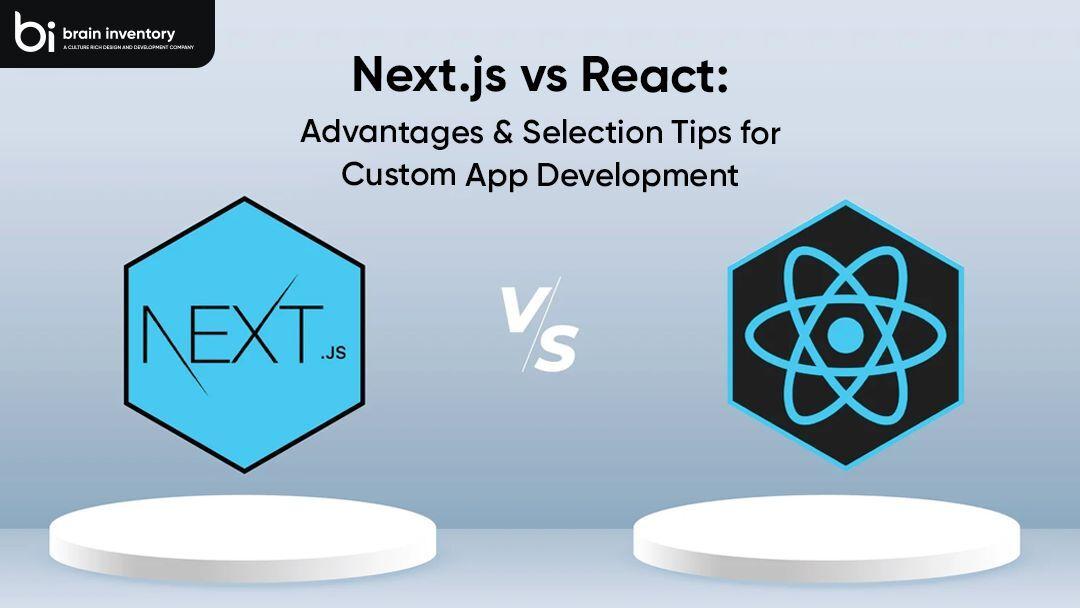Next.js vs React: Advantages And Selection Tips for Custom App Development

Quick Summary: React and Next.js are popular JavaScript libraries for developing custom app development. Both are open-source projects maintained by Meta (formerly Facebook).
React, established in 2013, is a JavaScript library that allows developers to create reusable UI components. Over the years, it has become widely adopted and is renowned as one of the most popular front-end libraries. Utilizing a declarative programming style, React focuses primarily on the app’s view layer.
Next.js, introduced in 2016 by Vercel, is a React framework facilitating server-side rendering and static site generation for React apps. Its goal is to simplify the process of building production-ready React applications, offering features like automatic code splitting, straightforward page routing, and pre-configured build artifacts.
This blog presents an in-depth comparison of React and Next.js to aid developers in selecting the most suitable framework for their upcoming projects.
What is React?
React is an open-source JavaScript library created by Facebook for building user interfaces. It allows developers to build reusable UI components and manage the view layer for web and mobile apps.
Some key things to know about React:
React is only focused on the UI layer. It is often combined with other libraries and frameworks like React Native for mobile development, Next.js for server-side rendering, Redux for state management, etc.
React uses a declarative paradigm that makes coding UI easier and more intuitive. Developers describe what the UI should look like based on state rather than imperatively manipulating the DOM.
React uses a component-based architecture where UIs are built out of reusable components. These components manage their own state and render UI based on props.
React uses a virtual DOM that improves performance. It minimizes expensive DOM operations by batching updates and using a virtual representation of the real DOM.
React supports one-way data binding from the state to the UI. When state changes, components efficiently re-render only the updated parts.
What is Next.js?
Next.js is a React framework that provides several additional features beyond React itself, including:
Routing – Next.js handles page routing out of the box, allowing you to build single-page applications with multiple views/pages without having to integrate a separate router.
Server-Side Rendering – Next.js pre-renders pages on the server, enabling faster first-load times and allowing search engines to crawl content. Pages are still interactive like a single-page app.
Code Splitting – Next.js automatically splits code into separate bundles to optimize performance. Pages only load necessary code.
API Routes – API routes can be built directly within Next.js, avoiding the need for a separate API server.
Static Site Generation – Next.js can statically pre-build and export pages at build time for pure static hosting without Node.js.
TypeScript Support – Next.js has built-in TypeScript support with no additional configuration required.
In summary, Next.js builds on top of React with extra tools and functionality like routing, server-side rendering, and optimized performance. This can accelerate development for certain types of web applications.
Differences Between React and Next.js
Next.js and React have some key differences that impact how they are used for custom web development:
Routing
React is a JavaScript library that requires adding a routing library like React Router for client-side routing. Next.js has file-based routing built-in which makes routing simpler.
Next.js generates pages and routes automatically based on files in the pages directory. React requires manually configuring routes.
Server-side Rendering
Next.js supports server-side rendering by default for faster initial page loads. React is client-side only rendering by default, requiring extra configuration for SSR.
Next.js pre-renders pages on the server. React only generates HTML on the client side. Pre-rendering in Next.js is great for SEO.
File-based Routing
As mentioned above, Next.js uses the pages folder to automatically handle routing. React requires implementing routing logic separately.
Pages in Next.js map directly to a route based on their file name and location. This makes routing simple and intuitive.
Simpler Project Structure
Next.js enforces a clear project structure with pages, public, and server directories. React is more flexible but less opinionated about structure.
The Next.js folder structure conventions can help simplify development and improve organization. React requires more decisions about project structure.
Developer Experience
Next.js offers an excellent developer experience out of the box with features like Fast Refresh, Image Optimization, and Automatic Code Splitting. React requires more configuration.
Next.js offers a zero-config, optimized setup for many common web development tasks. React provides flexibility at the cost of more manual setup.
When to Use React
React is a good choice for simple, static sites that don’t require server-side rendering. Here are some examples of when React may be preferable over Next.js:
-Building a marketing or informational site with mostly static content. React provides a fast and streamlined way to create an interactive UI with minimal dependencies.
-Prototyping or creating a proof-of-concept for a new web app. React lets you quickly iterate on ideas before introducing more complexity.
-We are creating interactive widgets or components to embed in an existing site. React components are portable and can easily be reused across projects.
-Developing browser-based games or visualizations that don’t rely on SEO. React offers excellent client-side performance for complex UIs that require high interactivity.
-Building Chrome extensions or other browser add-ons where SEO is irrelevant. React can create smooth experiences contained solely within the browser.
-Working with a development team experienced in React but not Next.js. Leveraging existing expertise may outweigh switching to a new framework.
When to Use Next.js
Next.js is ideal for complex, dynamic websites and web applications that require server-side rendering (SSR). Here are some of the key advantages of using Next.js:
Faster initial page loads: Next.js pre-renders pages on the server, so the initial page loads extremely quickly. This results in a better user experience compared to client-side rendered apps.
SEO friendly: Since pages are pre-rendered on the server, Next.js sites are indexed better by search engines compared to client-side apps. This is critical for marketing sites.
Simpler page routing: Next.js provides file-system-based routing so you don’t need to set up routing manually. This makes it easier to create complex page structures.
Full-stack capabilities: Next.js allows you to add backend code in the same project instead of having a separate backend. This makes it perfect for building full-stack web applications.
Hybrid: SSG + SSR: Next.js allows generating static pages at build time (SSG) while supporting SSR. This provides the best of both worlds.
TypeScript support: Next.js has first-class support for TypeScript, which is great for large-scale applications.
Rich ecosystem: Next.js has a rich ecosystem of plugins and modules for features like analytics, styling, CMS, etc.
Performance Comparison
Next.js provides faster time-to-first byte (TTFB) compared to React due to its server-side rendering (SSR) capabilities. With React, the initial HTML served is essentially empty, requiring client-side JavaScript to execute before the page is rendered. This leads to slower initial load times.
In contrast, Next.js generates HTML on the server. The initial HTML served already contains page content and markup. This allows the page to load faster visually for the user. There is no blank loading state. While React apps can implement SSR, Next.js handles it out of the box with no extra configuration needed.
Next.js prerenders pages at build time, further optimizing TTFB. The HTML for different routes is generated upfront instead of on each request. For SEO and performance, prerendering allows content to be immediately visible to search engines and users. Overall, the SSR and prerendering capabilities of Next.js provide significant TTFB improvements over client-side-only React apps.
SEO Comparison
Next.js has a clear advantage when it comes to SEO over React. This is because Next.js utilizes server-side rendering (SSR), while React applications are client-side rendered by default.
With SSR, the HTML content is generated on the server. This means that search engine crawlers can crawl and index the content more easily since the content is readily available. React applications, on the other hand, render HTML on the client side after the JS bundles have loaded. This can make it more difficult for crawlers to properly crawl and index React app content.
Next.js pre-renders all pages ahead of time during build time. It generates static HTML pages that can be served to search engine crawlers. This makes it much easier for Next.js sites to be indexed and ranked well in search engines.
React sites can still be optimized for search engines, but they require extra configuration like server-side rendering and generating sitemap.xml files. Next.js handles a lot of these optimizations by default with SSR and automatic static page generation.
So in summary, if SEO is a priority, then Next.js is likely the better choice over React due to its built-in SSR capabilities and easier search engine indexing. Next.js takes care of many critical SEO factors out of the box.
Conclusion
Overall, Next.js builds on React with extra server-side rendering, routing, and tooling functionality. It offers a faster development experience and optimized performance. React provides a flexible foundation for building complex UIs. Consider using Next.js if SEO and speed are critical or you want a simplified setup. Prefer React for apps with heavy interactivity and dynamic data. If you’ve decided to hire a ReactJS or NextJS developer, we’re here to assist. With Brain Inventory, you’ll gain access to a vast talent pool of senior-level remote developers, tailored to your time zones and English proficiency. Our seasoned recruiters will ensure each candidate meets your specific requirements and cultural fit. Clear any doubts and schedule a consultation today.

Have an idea?
Get in touch, we’d be
happy to hear from you
We are always looking out for new collaborations, whether you are a client who is passionate about a project or a talent who is interested in joining our team, our doors are always open.
locate us

India (HQ)
618, Shekhar Central, Palasia Square, A.B Road, Indore, Madhya Pradesh, 452001
+918109561401

United Kingdom
Brain Inventory, SBVS, 8 Roundhay Road, Leeds, UK, LS7 1AB
+18008209286

Canada
44 Main Street East Milton, ONCanada L9T 1N3
+4166696505

Jordan
185 Wasfi Al-Tal Street, Ammon Oasis Complex P.O Box 4724 Amman 11953 Jordan
+960770781000

USA
720 Seneca St Ste 107 Seattle, USA 98101
+1(206)6533419
if it's digital,we'll make it.
- Numetric - Online Accounting Software similar to QuickBooks
- Bloomia - Kegel exercise
- Virifi - Blockchain Powered Document Certification & Signing Platform
- Revolution Travel CRM - Custom CRM Built for Travel Agents
- Fatoura - Online Invoicing Platform
- My Fit Mantra - Your health partner
- Ocureel - Relation Building and video sharing Application